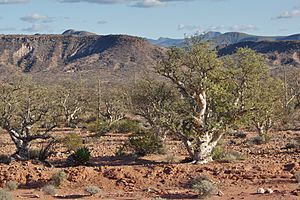Pachycormus discolor facts for kids
Quick facts for kids Pachycormus discolor |
|
|---|---|
 |
|
| Conservation status | |
| Scientific classification | |
| Genus: |
Pachycormus (plant)
|
| Species: |
discolor
|
| Synonyms | |
|
Synonymy
Schinus discolor Benth., (1844)
Veatchia discolor (Benth.) Brandegee, (1889) Rhus veatchiana Kellogg, (1863) Veatchia cedrosensis A.Gray, (1884) Veatchia discolor var. pubescens (S.Watson) I.M.Johnst. (1924) Veatchia discolor var. veatchiana (Kellogg) I.M.Johnst. (1924) Bursera pubescens S.Watson, (1889) |
|
The Baja elephant tree (scientific name: Pachycormus discolor) is a unique plant from the cashew family. It is also known as torote blanco or copalquín. This special tree is the only species in its group, called Pachycormus.
This tree grows only in the Baja California peninsula in Mexico. It has three different types, or varieties. The Baja elephant tree is known for its thick, twisted trunk and bark that peels off like skin. It is also a succulent plant, meaning it stores water. People have described its look in fun ways. Some say it looks like an elephant's trunk holding flowers. Others say it looks like a giant radish sticking out of the ground.
Most of the year, this tree is dormant because it loses its leaves in dry weather. But after it rains, green leaves grow. In late spring or summer, the leaves turn yellow and fall off. Then, bright red, cream, or pink flowers appear, making the tree look amazing.
Contents
What the Baja Elephant Tree Looks Like

The Baja elephant tree can be a tree or sometimes a shrub. It often grows in strange, twisted shapes. On the Pacific coast, strong winds can make it grow flat or spread out. The trunk is usually about 60 to 80 centimeters (2 to 2.5 feet) wide.
The trunk has a smooth, skin-like outer bark that peels off every year. Underneath this papery bark is a spongy, blue-green inner bark. This inner bark is about 2.5 to 5 centimeters (1 to 2 inches) thick and can do photosynthesis (make food from sunlight). The inner bark also produces a milky sap. This sap dries into a clear, hard gum or resin.
Leaves and Flowers
The leaves of the elephant tree are dark green and made of several smaller leaflets. They are covered in fine hairs. These leaves fall off during dry periods. Each leaf has 3 to 15 small, oval-shaped leaflets, about 3 to 10 millimeters (0.1 to 0.4 inches) long. The size of the leaves can be different depending on the tree's variety.
The flowers grow in clusters. Some trees have only male flowers, and others have only female flowers. The flowers can be yellowish, pink, or red, depending on the variety. The petals are about 5 millimeters (0.2 inches) long and have a pointed tip. The fruits are smaller than the petals and are also hairy. Flowers usually appear in May and can bloom until September if there is enough moisture.
Where the Baja Elephant Tree Lives
This tree grows only in the Baja California peninsula in Mexico. It is found in the states of Baja California and Baja California Sur. Each of the three varieties lives in its own specific part of the peninsula.
For example, one variety, pubescens, grows from San Fernando Velicatá down to La Paz. Another rare variety, veatchiana, is found on Cedros Island, Isla Natividad, and the western Vizcaino Peninsula. The third variety, discolor, lives on the islands of Magdalena Bay and the western side of the southern Sierra de la Giganta mountains.
Habitat and Climate
The Baja elephant tree mostly lives in the Baja California Desert and the Vizcaino desert. However, it can also be found in cooler mountain areas, like the Sierra de La Giganta. In these mountains, the discolor variety grows on hillsides. In ravines, it can form thick groups of trees. It grows from sea level up to about 450 meters (1,500 feet) high.
On Cedros Island, the veatchiana variety grows in sandy areas and canyons. It grows tallest in these spots. Near the coast, it grows flat because of the desert winds.
The northern and central parts of its home, like Laguna Chapala and San Ignacio, get very hot in summer. Daytime temperatures are usually 34 to 45 degrees Celsius (93 to 113 degrees Fahrenheit). In winter, nights can be cool, sometimes dropping to 3 degrees Celsius (37 degrees Fahrenheit). Most rain comes from hurricanes between August and October. Some years have no rain at all, while others get some winter rain from the north.
Uses of the Baja Elephant Tree

People who collect succulent plants sometimes grow these trees in pots. They look best in full sunlight. Only trees grown from seeds will develop the thick, swollen trunk. This tree can handle a little bit of frost. Its tips might get damaged at 0 degrees Celsius (32 degrees Fahrenheit), and it can die if temperatures drop to -4 degrees Celsius (25 degrees Fahrenheit).
A long time ago, a lot of the tree's bark was sent to Europe. It was used in a process called tanning, which turns animal skins into leather.
Images for kids
-
Detail of the leaves of var. veatchiana on Cedros Island
-
Growing in the vicinity of Cataviña with Pachycereus pringlei
See also
 In Spanish: Pachycormus discolor para niños
In Spanish: Pachycormus discolor para niños





